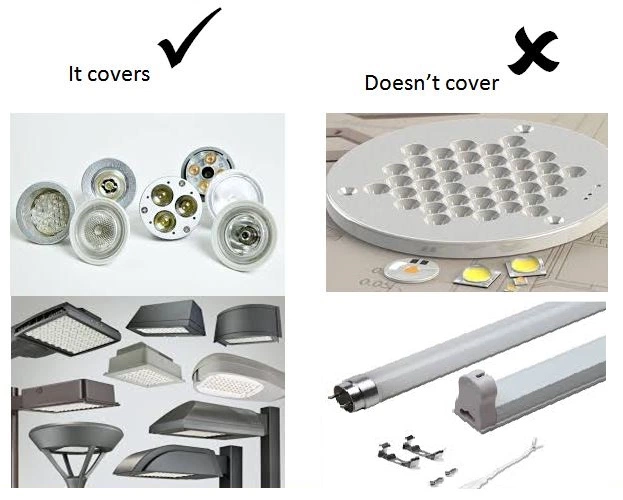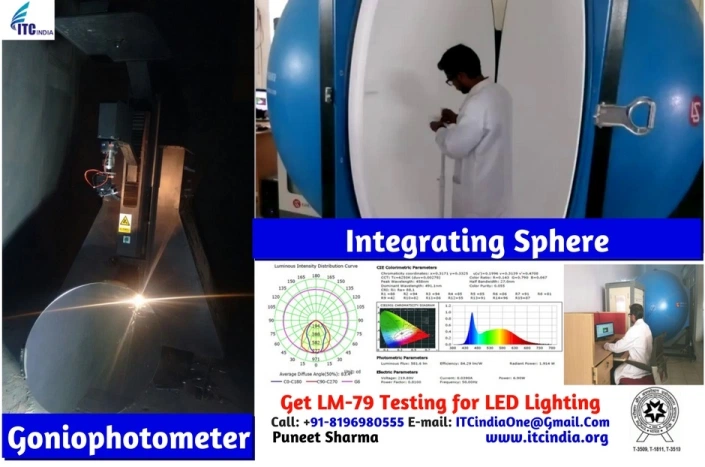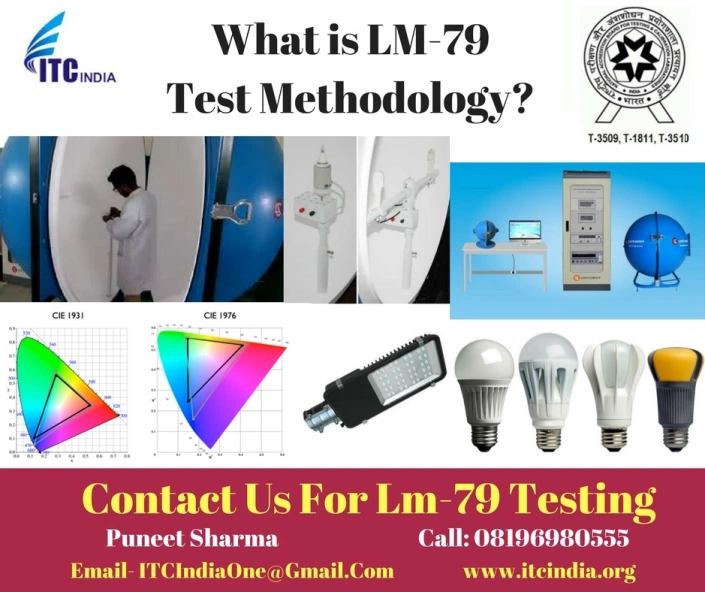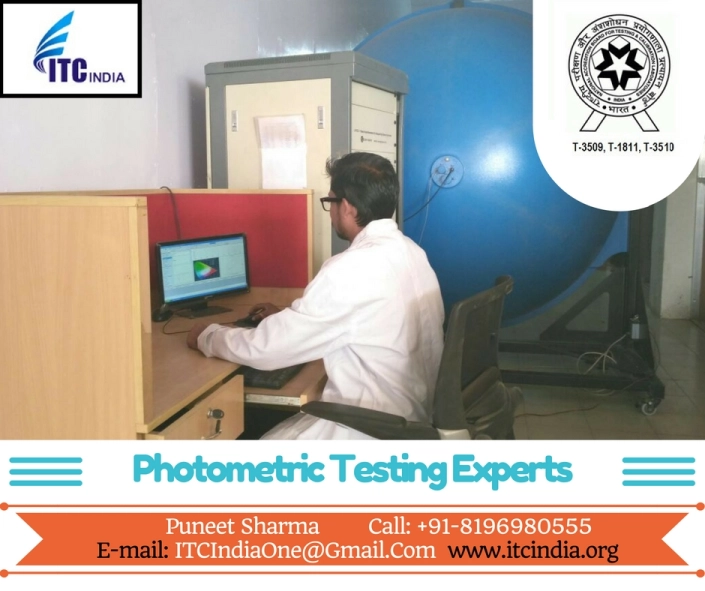Photometric Testing: Lamp – LED – Luminaire Testing
What is Relative Photometry?
What is relative photometry?
Total Lumen output of a bare lamp is measured in relative photometry for more clarity; the total luminous flux of the lamp is measured separately without the Fixture. In IES LM-80- 08, IES LM 82-12, the relative photometry is used. The purpose is to find light output, Efficacy, color over temperature for light engines.
Relative photometry can measures:
- Total luminous flux of the bare lamp
- Luminous intensity distribution
- Scale the luminous intensity values by the ratio of the measured lamp lumens to the rated lamp lumens.
Some important features regarding relative photometry:
- Relative photometry is performed for luminaries with conventional sources.
- Luminaries test is referenced to the luminous Flux measured for bare lamp.
- The result produced is in the units of candela per rated lumens( cd/rated lm)
- It can also measure the efficiency of luminary.
- Normalize ballast factor, Lamp age.
- Specific lamp performance doesn’t matter
Relative photometry is not used in SSL with integrated lamps due to many reasons:
- The LED‘s are difficult to remove from the Luminaries.
- A large number of LED devices will not work properly without heat sinks provided with luminaries.
- The thermal environment that the LED devices undergo within the luminary is often radically different from the thermal environment it will practice in its “bare lamp” configuration.
If you’re Buyers Demanding for LM-79 Testing– Contact Now!
Wish this blog post will be help. If you have any other questions, please feel free to contact us. ITCIndia team looking forward work with you and get better together!
Mr. Puneet Sharma | Call: 08196980555 | E-mail: [email protected]
Get Instant Quotations, Fill the Enquiry form:
This entry was posted in LED Testing, LED Tube Light Safety Testing, LM 79 Testing and tagged Absolute photometry and relative photometry, absolute photometry astronomy, Absolute photometry has relative benefits for LED and SSL, aperture photometry, candela, differential vs. absolute photometry, Goniophotometry of LED Luminaires, How to do photometry, how to read photometric data, IES Photometric Testing, LED Testing Standards Overview, List of Nabl Approved Photometric testing lab, List of Nabl Approved Photometric testing lab india, list of nabl approved photometric testing laboratory, List of Nabl Approved Photometric testing labs, Nabl Approved Photometric testing lab, Nabl Approved Photometric testing lab india, Nabl Photometry testing, NABL Testing Labs - NABL & ISO 17025 Certified Lab, photometric measurement, Photometric Measurement of LED Luminaires, Photometric Testing: Lamp - LED - Luminaire Testing, Photometry Lab, photometry pdf, photometry physics, photometry software, Photometry testing, Photometry testing India, Photometry testing lab, PHOTOMETRY TESTING LABORATORIES, Relative and absolute photometry, Relative Photometry - ITCIndia, Searches related to Relative Photometry, Searches related to What is Relative Photometry?, types of photometry, uses of photometry, what does absolute lumens mean.
What are LM 79 Test Outcomes?
What are LM 79 Test Outcomes?
LM-79 is approved test method for electrical and photometric measurements of Solid State Lighting Products. It describes the procedure in measuring total luminous flux, electrical power, luminous intensity distribution, chromaticity under standard conditions. It covers LED based SSL products with control electronics and heat sink incorporated with AC or DC power supply. This does not include LED chips, LED package or LED module but luminaries (fixtures incorporating light source) as well as integrated LED lamps.
The equipment used in LM-79 is integrated sphere and goniophotometer.
Integrating Sphere Goniophotometer
The test report shall list all significant data for each SSL product tested together with performance data. The outcomes of the LM-79 test are:
- Correction factor applied ( e.g. spectral mismatch, self absorption , intensity distribution etc.)
- Measured total luminous flux( lumen(lm)), input voltage(v), current(a), power(w), Luminous intensity distribution(cd), efficacy(lm/w)
- Color quantities( chromaticity coordinates, CCT, CRI )
- Spectral power distribution
- Bandwidth of spectoradiometer, if spectral distribution and/or color quantities are reported.
- Statement of uncertainties (if required)
- Deviation from standard operating procedures, if any.
Here is the link of a test report issued by our prestigious company. LM 79 Test Outcomes
If you’re Buyers Demanding for LM-79 Testing– Contact Now!
Wish this blog post will be help. If you have any other questions, please feel free to contact us. ITCIndia team looking forward work with you and get better together!
Mr. Puneet Sharma | Call: 08196980555 | E-mail: [email protected]
Get Instant Quotations, Fill the Enquiry form:
This entry was posted in LED Testing, LM 79 Testing and tagged and TM-21, Best LM 79 Testing Lab, CCT and power factor . Contact us Now, Chromaticity coordinates, CRI, Electrical Properties, Get Lm 79 Test Report in 5 days, ies lm-80, Input AC power, Input RMS AC current, Input RMS AC voltage, Input voltage frequency, Instrument solutions for lm-79, Lamps & Luminaires - EMC-EMI Testing lab in Delhi, Lamps & Luminaries |LED Testing lab in Delhi, led light testing laboratory in india, LED Lighting Facts® LED Lumen Maintenance and Warranty Labele, led testing lab in india, LID, list of nabl accredited labs, list of nabl accredited labs for LED testing, list of nabl accredited labs for Lm testing, List of NABL Labs in India, Lm 79, lm 79 80 standards, LM 79 testing by NABL - Accredited lab in just 5 days, lm 79 testing labs in india, lm 79 testing labs in maharashtra, lm 80 report, lm 80 standard pdf, LM-79 LM-80 Technical Report, LM-79 Test Report, LM-79 test reports and luminaire LED quality and performance, LM-79 Testing Laboratory, lm-79 Testing | lm 79 test report - Electrical Safety Testing Lab ITC India, lm-80, lm79 and lm80 standards, LM79-08 Approved Method, Lumens, luminaries testing lab, Luminous efficacy (lumens/W), Luminous flux (lumens), Luminous intensity distribution (candelas), nabl accredited labs for LED testing, nabl approved lab list, NABL Lab for lm 79 testing, National Accreditation Board for Testing and Calibration Laboratories, Photometric lab, Photometric Properties, photometric testing labs, Photometric Testing: Lamp - LED - Luminaire Testing, sample lm79 report, Searches related to What are LM 79 Test Outcomes, SPECIFIC CRITERIA for PHOTOMETRY TESTING LABORATORIES, Testing efficient luminaires and LED retrofit lamps, tm 21, tm-21 led, Top lm 79 testing lab in Ahmedabad, Top lm 79 testing lab in bangalore, Top lm 79 testing lab in india, Top lm 79 testing lab in Mumbai, Top lm 79 testing lab in New Delhi, Top lm 79 testing lab in pune, Understanding LED tests IES LM-79, What are LM 79 Test Outcomes?.
What is LM 79 Test methodology?
What is LM 79 Test methodology?
LM 79 is an approved method that describes the procedure to be followed and precautions to be observed in performing reproducible measurements of total Luminous flux, electrical power, luminous intensity distribution, chromaticity of Solid-State lighting products for illumination purposes under standard conditions.
LM 79 covers- LED based SSL products with control electronics and heat sinks. Luminaries (fixtures incorporating light source) as well integrated LED lamps.
LM 79 doesn’t cover– fixtures without a light source, SSL products that require external operating.
LM 79

Test method for total luminous flux Measurements:
The total luminous flux of SSL product shall be measured with an Integrating Sphere or Goniophotometer. The method may be chosen depending upon what other measurements quantities (color, intensity distribution) need to be measured., the size of SSL products, and other requirements.
The integrating sphere is suited for total luminous flux and color measurements of integrated LED lamps and relative small size LED luminaries. Advantage of using integrating sphere is that it does not requires the “ Dark Room”., and also it is less time consuming.
The Goniophotometer provides measurements of Luminous Intensity Distribution as well as total luminous flux. It can take measurements of larger size luminaries as well as small size luminaries. It has to be installed in Dark Room. Measurements in goniophotometer are time consuming.
| Integrating Sphere | Goniophotometer | |
| Conditions | No Dark room | Dark Room |
| Size of SSL | Small Size luminaries | Large size as well as small size Luminaries |
| Measurements | Total Luminous Flux | Light Intensity Distribution , Total Luminous Flux |
| Duration of Test | Fast Measurements | Time consuming as compared to Sphere photometer. |
If you’re Buyers Demanding for Luminaries Testing– Contact Now!
Wish this blog post will be help. If you have any other questions, please feel free to contact us. ITCIndia team looking forward work with you and get better together!
Mr. Puneet Sharma | Call: 08196980555 | E-mail: [email protected]
Get Instant Quotations, Fill the Enquiry form:
This entry was posted in LED Bulb Testing, LED Testing, LM 79 Testing, LM-79 Testing | LM-79 Test Approved Methods and tagged 80 and other LED Standards, CCT and power factor . Contact us Now, CRI, Electrical and Photometric tests as required, esting efficient luminaires and LED retrofit lamps, How to check in LM-79, ies lm-80, IESNA LM-79-2008 Approved method, Instrument solutions for lm-79, istmt, LED and Lighting Testing Specialists, led driver testing equipment, led lamp testing equipment, led light testing equipment in india, led light testing procedure, LED Lighting Facts® LED Lumen Maintenance and Warranty Label, led lighting standards testing and certification, LED Luminaire Lifetime: Recommendations for Testing and Reporting, LED Luminaires Lamps Testing, led test blood, LED test labs for LED life testing, LED testing and LED test services for light measurement, led testing device, led testing standards, LED Testing Standards Overview, LID, light measurement and reliability, list of approved testing laboratories in india for LM-79, list of approved testing labs in india for LM-79, list of labs under lm-79, list of testing laboratories in india for LM-79, Lm 79, lm 79 80 standards, LM 79 Test Laboratory - LED/SSL Luminaires, LM 79 testing by NABL - Accredited lab in just 5 days, lm 79 testing labs in india, lm 80 standard pdf, LM-79 & LM-80 | Decorative Outdoor Lighting, LM-79 LM-80 Technical Report - ITCIndia, LM-79 Test Labs, lm-79 test procedure, LM-79 Test Report, LM-79 test reports and luminaire LED quality and performance, LM-79 Testing - ITCINDIA, LM-79 testing laboratories, LM-79-08 - IES, lm-80, lm79, LM80, Lumens, making sense of led testing standards, NABL approved test labs for LM-79, need/requirement in LM-79, need/requirement in LM-79 Testing, need/requirement under LM-79, need/requirement under LM-79 Testing, Performance measurement of lamps and luminaires, performance testing of lighting products, performance testing of lighting products - ITCIndia, Photometric Measurement of LED Luminaires, Photometric Testing: Lamp - LED - Luminaire Testing, Production & Testing — LED professional - LED Lighting Technology, Quality LED Testing, sample lm79 report, Searches related to LED Luminaires Lamps Testing, Searches related to What is LM 79 Test methodology?, Solutions for LM-79, Sorting out LM 79, Testing Lab Requirements, Testing Methodology, tm 21, tm 21 led testing, TM21 and L70, Understanding IES LM-79 & IES LM-80, what are the Parameters Required under LM-79 testing, What is LM 79 Test methodology?, WHAT is LM-79 Testing, what to check in LM-79, who do LM-79 Tests/testing, Who will do testing in LM-79, Why testing is necessary under LM-79, Why to check in LM-79.
Photometric Testing Experts
Searches related to Photometric Testing Experts, What is Photometric Testing, Photometric Test Procedure, Photometric Test Report, Photometric Testing India, LM-79 Testing Experts, Photometric Testing labs, LED Testing Experts, Photometric Testing for LED Lighting
If you are looking for Photometric Testing Laboratory for LED Lighting In your Area, ITCIndia Electrical Safety testing Laboratory Approved from NABL. ITC India one of the best Photometric Testing Laboratory in India, Mumbai, Chennai, Ahmedabad, New Delhi, Pune, Kolkata, Bangalore, Hyderabad, Surat, Visakhapatnam.
ITCIndia “Institute of Testing and Certification India Pvt. Ltd” are a leading testing lab having a NABL accreditation under ELECTRICAL, ELECTRONICS and PHOTOMETRY testing with certificate no. T-3509, T-3570 and T-1811. ITCIndia Lab is following the procedure as required by International Standard IEC 17025 and is already certified for ISO/IEC 17025.
As the development of LED technology continues to grow and diversify, the need for consistent and standardized testing procedures for LED has become more prevalent than ever. ITCIndia is NABL Accredited laboratory for Photometric Testing for LED Lighting, LM 79 Testing.
Institute of Testing and Certification India Pvt. Ltd has made strides to stay current with the new testing standard LM-79 set forth by the IESNA (Illuminating Engineering Society of North America). In addition, “ITCIndia” testing is now a priority when testing our LED light systems for more reliable results.
ITCIndia Lab has made strides to stay current with the new testing standard LM-79 set forth by the IEC/EN 60598. In addition, ITC INDIA testing is now a priority when testing our LED light systems for more reliable results. Fixtures tested by LM-79 standards will now feature a Lighting Facts label provided through the program created by the IEC/EN.
LM-79 Electrical and Photometric Measurements of Solid-State Lighting Products
Approved method describing procedures and precautions in performing reproducible measurements of LEDs:
- Total luminous flux
- Electrical powers
- Luminous Intensity distribution
- Efficacy (lm/watt)
- Chromaticity
How To do Photometric Testing?
Check Our Photometric Testing Scope
Absolute Photometry Basis
- LM-79 requires complete luminaire testing
- Traditionally, photometric evaluation of lighting products is based on separate tests for lamps and luminaires
- For SSL products, LED lamps typically cannot be separated from their luminaire because of heat effects
Relative vs. Absolute Photometry
Relative testing – Lamps of interest and luminaire are measured separately. Then the actual light distribution and intensity of the complete luminaire of interest is derived by normalization of the test data
Absolute testing – The actual light distribution and intensity of the luminaire of interest is measured directly from the complete luminaire.
For your better understanding, we are going to show you the Photometric Test report of latest LED in the following:
Learn more about this Photometric test >
If you’re Buyers Demanding for Photometric Testing– Contact Now!
Wish this blog post will be help. If you have any other questions, please feel free to contact us. ITCIndia team looking forward work with you and get better together!
Mr. Puneet Sharma | Call: 08196980555 | E-mail: [email protected]
Get Instant Quotations, Fill the Enquiry form:
This entry was posted in LED Testing, LM 79 Testing, Photometric Testing and tagged competitive and Affordable cost to get Lm 79 testing, Goniophotometer for Photometric Testing, How To Build The Darkroom For Goniophotometer?, Integrating sphere for Photometric Testing, Intigriting spair for Photometric Testing, led light testing laboratory in india, led testing labs in india, lm 79 certificate, lm 79 test, LM 79 testing by NABL - Accredited lab in just 5 days, lm 79 testing labs in bangalore, lm 79 testing labs in india, lm 79 testing labs in maharashtra, lm 79 testing labs in mumbai, LM-79 Test Report, Lumen test difference between integrating sphere and goniophotometer, photometric and optical testing, photometric test procedure, photometric test report, photometric testing equipment, Photometric Testing Experts, Photometric Testing for LED Lighting - ITCIndia, photometric testing laboratory, photometric testing labs, Photometric Testing Report, photometric testing uk, photometric testing wiki, Photometric Testing: Lamp - LED - Luminaire Testing, PHOTOMETRY TESTING LABORATORIES, Practical Photometric Testing of SSL Products, sample lm79 report, Searches related to LM-79 testing labs in india, Searches related to Photometric Testing for LED Lighting, Spectrophotometer and Integrating Sphere Test System, Top Light Integrating Spheres - Measure Automotive Lighting, What is a photometric test?, what is photometric testing.



